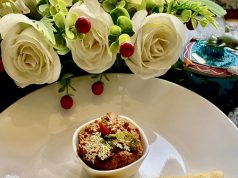Culinary Chronicles
 By Yasmin Rahul Bakshi
By Yasmin Rahul Bakshi
Sauces are vital in Indian-Oriental cooking for the taste and appearance. When the Hakka Chinese immigrants in Tangra area of “Calcutta” started vending their cuisine commercially in the mid-nineteenth century, they attempted to make it spicier to appeal to the Indian palate.
The first Sichuan restaurant was set up at Taj Mahal Hotel in “Bombay” in 1974 that offered a hot and spicy Chinese menu to lure the Indian clientele.
Procurement of ingredients like the Sichuan Peppers was an issue. Hence the cuisine was improvised by adding more sauces and thickening agents.
Little did Chef Nelson Wang know, what he was curating with the sauces from Manchu for his guests at the Cricket Club of India in Bombay, would one day grow into India’s most popular dishes – Chili Chicken and Manchurian. Born in Calcutta, he was the father of Indo-Chinese cooking and a third generation Chef who experimented by adding additional condiments like ginger, garlic along with soy and chili sauces with a hint of umami salts.
The fire soon spread through the entire nation and today every nook and corner of each city witnesses a Chinese eatery, big or small including Dehradun and Mussoorie.
Both the towns have proved to be magnanimous in embracing people and their cultures. A couple of Chinese families and many Tibetans settled down here and have become embedded in the highland culture and their food has allured most of us.
Out of many, one Chinese and Tibetan eatery that stood majestically for decades in the yesteryears on the Mall Road in Mussoorie was Amitash – The Rice Bowl. Perpetually thronged by the people and the charming owner who added warmth to the hospitality. It was always a recommended place for flavoursome Oriental cuisines.
In the early eighties, Wanchuk Lhatsang started a restaurant called the “Chopsticks” on the Mall Road where Hotel Howard International stands in the current times. Which later was transferred above the Rialto Cinema gate by the name of “Amitash”. Till the mid-eighties his son, Sherab Lhatsang popularly known as Sherry, ministered this property until he migrated to the United States leaving the responsibility on Yankeela Lhatsang’s potential shoulders.
She along with the flawlessly tutored chefs by her father provided the best Oriental food to the town for years that served authentic dishes. Some years ago, the owner proceeded to foreign lands and chose to close down this iconic place.
Today, Amitash is endorsed in the folios of the history of Mussoorie. This and many more eateries in the Happy Valley segment have had been prominent in catering to sterling or close to original flavours.
Ingredients:
For marinating
- Boneless chicken – ½ kg
- Lemon juice – 1 Tbsp
- Corn flour – 3 tsp
- Salt – ¼ tsp
- White pepper – 2 pinches
Other ingredients
- Soy sauce – 2 Tbsp
- Vinegar – 1 Tbsp
- Sugar – 1 tsp
- Water – 6 Tbsp
- Corn flour – 2 tbsp
- Oil – 2 Tbsp
- Garlic – 6 cloves (fine chopped)
- Ginger – 2 inches (fine chopped)
- Dried whole red chilies – 5
- Sichuan pepper powder – ½ tsp
- Onion – 1 medium (chopped)
- Roasted peanuts – ½ cup
- Spinach – ¾ cup (optional)
- Oil – for frying
- Egg – 1
- Monosodium glutamate – 1 pinch
- Salt – as per taste
Method:
- Marinate the chicken with lemon juice, salt, white pepper and corn flour for half an hour.
- Mix soy sauce, vinegar, sugar, salt, water and corn flour in a bowl and keep aside.
- Lightly beat the egg and mix it in the marinated chicken.
- Heat oil for frying in a pan and fry the chicken pieces until done.
- In another wok or pan heat 2 Tbsp of oil. Then add in the garlic, ginger, onions, spinach leaves and chilies. Saute for 2 minutes on high flame.
- Add in the Sichuan pepper powder.
- Add the chicken and peanuts, saute for a minute.
- Sit and pour in the mixture of soy sauce, vinegar, sugar, water, salt and corn flour.
- Add the pinch of monosodium glutamate and cook for a minute or so until the sauce thickens.
- Serve hot with rice or noodles.
(Yasmin Rahul Bakshi is an accomplished senior consultant Chef and a food historian. A widely travelled Army wife from the Mussoorie hills with exposure to international cuisines & preserving recipes with the medium of food photography and digital content creation in the form of stories.)









